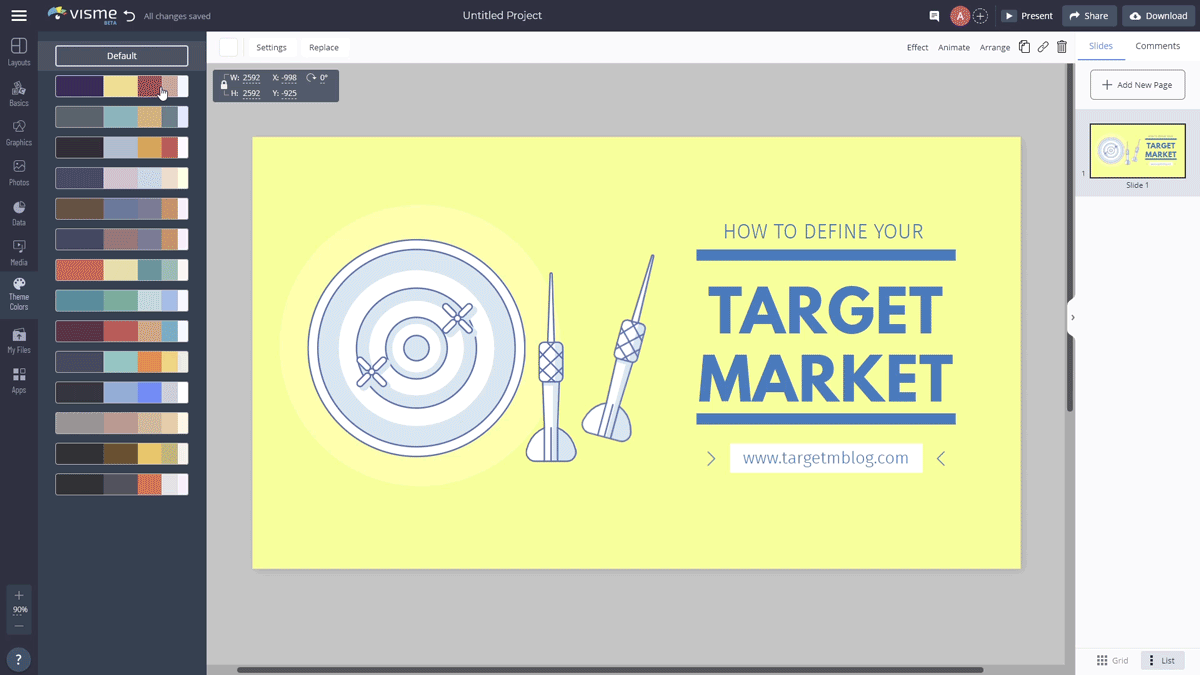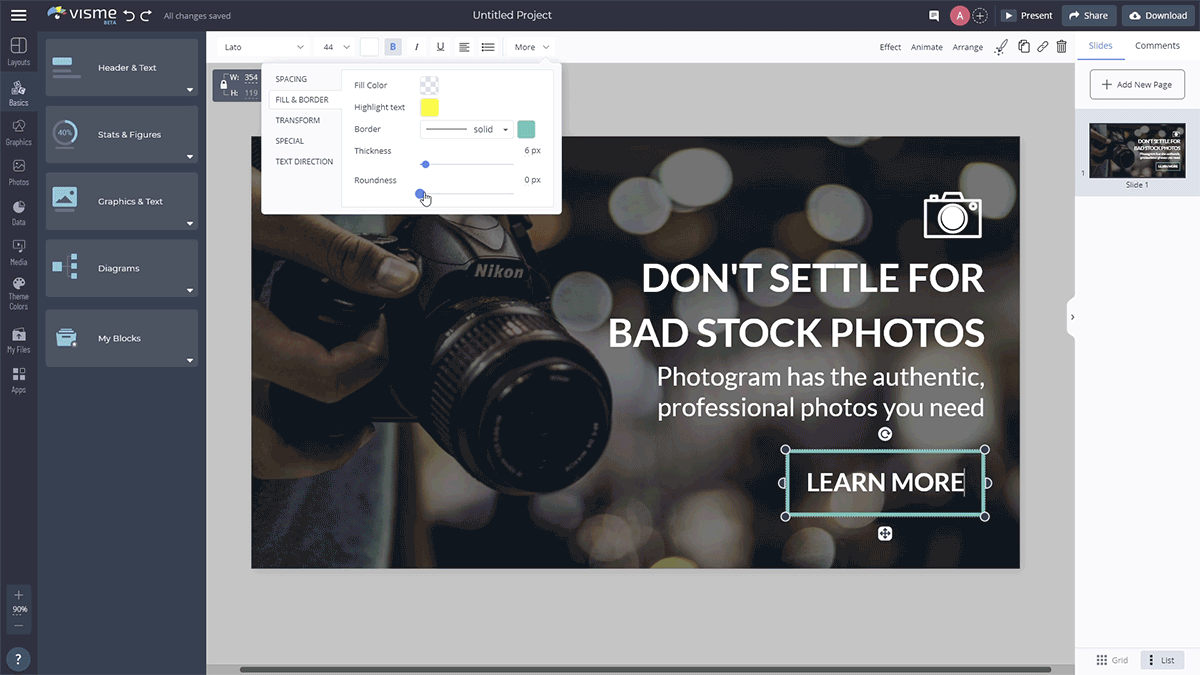How to Make Easy Incredible Digital Ads

Investing the time to upgrade your ad design quality is one of the best ways to increase your marketing performance. In this post, I've collected 8 tips that you can integrate into your creation process starting today.
Let's begin!
Why is Good Ad Design Important
Whether you're working in an advertising agency, are a marketing professional or are promoting your product, taking the time to invest in a new direction is a big decision. It's essential to understand how to design ads that generate conversions.
And bonus points if you learn to use a tool like Visme to upgrade your design.
But why is good ad design so important?
First, your ad design helps you stand out in an increasingly cluttered digital world. Beautiful design helps you consistently stand out to your audience.
Also, organic reach is an advertiser's best friend. When your audience shares your ad with their network, the impact of your ad spend skyrockets.
One social media scientist found that tweets with images are shared 94% more than tweets with no picture. Investing in quality design pays dividends when it comes to earning organic reach.
Third, excellent design improves your brand. When you get intentional about how you appear to your audience, you send high-quality signals about your product and team.
Now that we've explored some of the key reasons to invest in good designs for your brand, we'll transition to the tips you need to incorporate quality design into your ads.
However, if you're not entirely sold yet on the importance of design, please check out our short video tutorial on creating beautiful social media and web graphics with Visme.
8 Ad Design Tips to Power Up Your Advertisements
When it comes to bringing great design to life within your ads, building the habit of using a design tool is the best start. Sign up for a Visme account and begin to tweak – or totally revamp – your existing ads for the best outcome.
However, it can be incredibly daunting to face a new tool with capabilities you may not understand. Plus, it will help you know some of the basic design principles you can use with the right tools.
We'll begin with a high level overview of each tip before progressing to our more detailed how to section.
Tip #1: Convey a Clear Message
The first design tip for creating powerful ads is to highlight the key message for your brand and the specific campaign you're putting together.
Highlighting key messages requires you to know your unique selling proposition . Ads are a fantastic way to use visual elements and themes to amplify what your product does best.
Be sure that the ad you design conveys your message clearly and concisely so that your audience knows exactly what you're selling them at first glance.
The visuals and concise copy in this ad template below is the perfect starting point for a clear message that your audience won't be confused about.

Tip #2: Experiment With Variations Of Your Color Palette
Before you start an ad campaign to take your design to the next level, make sure to take stock of what you already have. This is especially relevant when it comes to your brand's existing visual identity .
Is one color used primarily as the background? Is another always used as an accent?
A subtle shift in the arrangement of primary colors is an excellent way to keep brand consistency while delighting your audience with some variation.
The style guide of the Broadcast Management Group is an excellent example of this tip in action.
Check out how they blend backgrounds and accent colors depending on the particular use case for their logo.
Using the Visme Brand Kit, you can easily set up color themes for each of your different primary colors so you can adjust your color schemes with a single click.

Tip #3: Add a Border To Your CTA
Adding a border to your primary call to action is a simple yet powerful visual element to create powerful ads. Many ad designers will already be utilizing borders of some kind in their existing ads.
However, becoming more intentional about where you utilize them is one of my favorite ad design tips. Why is this such a powerful technique to integrate into your workflow?
Enter the framing effect. Put simply, visual framing is how artists present the elements of their creation in relation to the whole. In photography, framing is how the photographer draws our eye to the main focus of the picture.
As marketers, the main focus of our ad is some variation of our unique selling proposition. Placing a border around this message helps us stand out because it's entirely unique to our brand.
In the template below, you'll see a call to action from a dentist. You can easily create this same effect by customizing this template with your information and keeping the shape around your CTA, or even changing it to something that matches your brand voice .

Tip #4: Make Your Ad Harmonious
Something incredible about the software age is we have endless design capabilities at our fingertips. Non-designers have more tools than ever before.
However, one of the best tips you can integrate to create powerful ads is visual harmony through simplification.
Visual harmony in design is when all of the elements you select for your design blend together in a unified way .
Simply, when you are creating your ad, make sure the way you present your unique selling proposition, your color choices and the visual elements you select all enhance each other.
Even professionally designed visual elements look out of place if there's no logical reason to include them.
This is why it's a good idea to start with a template like the one below. With so many design elements to choose from, starting with an idea of how many to use and where they should go to create a harmonious design can be helpful.

Tip #5: Embrace Naming Conventions
The next tip for designing ads is all about organization and collaboration. When you are working on many projects, perhaps with different clients or different projects, it's easy to get disorganized.
Embracing a naming convention system now will pay off massively in the future. There is no set formula for naming conventions, but if you need some guidance, the evok advertising team has a great system that I adapted for my use.
This is easy to do in Visme by naming your projects and organizing folders in a way that helps you easily find exactly what you're looking for.

Tip #6: Embrace an Experimental Mindset
A popular advertising tactic – especially with Facebook ad design – is to optimize campaigns using A/B split tests .
Bringing this mindset into your ad design process will help you optimize your ad design choices incrementally.
You can test out the validity of some of the tips offered here. For example, will a frame around your unique selling proposition in a border result in more conversion than an ad without the frame?
Additionally, you can brainstorm other experiments testing variations on your typical color layouts. Easily put together A/B tests by duplicating your design in Visme and making minor adjustments.
Tip #7: Tap Into Your Emotional Mind
According to an infographic from The University of Southern California's Applied Psychology program, 31% of advertising campaigns that overperform have content that evokes an emotional response vs. 17% that have rational content.
Utilizing emotion is a good reminder for ad designers that their primary responsibility is to stop someone in their tracks.
Depending on the unique selling proposition, it may be appropriate to use sentimental images, invite the reader to reflect on nostalgic memories, help them laugh, create a connection through empathy or help them feel passionate about a cause.
Color is a powerful tool for creating emotional undertones for your ad. Understand some of the likely emotions your brand colors evoke.

Then, utilize ad copy that connects your readers to the particular emotion. It is also essential to link your color design, copy, and unique selling proposition together in a harmonious way if you want to drive more conversions with this tip.
Tip #8: Make Your Ad a Flash Fiction
Stories are inherently memorable. Not only that, but our readers are hungry for them. In one study, 92% of consumers said they want brands to tell more stories in their ads .
It is not immediately obvious how to translate principles from long stories into a medium like ads.
It's important not to overthink it if you want to reap the powerful benefits from this tactic. Five storytelling motifs are easy to translate into your ad.
First, most stories have a hero, and this hero is your ideal customer.
Every hero has an object of desire. When it comes to our storytelling exercise, their object of desire is the value your unique selling proposition can create for our hero.
Third, most stories have a villain. The villain is the obstacle your product helps customers overcome.
Finally, there's your role in this drama. The creator of the ad is always the mentor to the hero.
Your ad is an opportunity to show the hero how to overcome the villain and attain the object of desire.
How to Create Your Ad Design in Visme
In the first two sections, we discussed the importance of investing in design and some of the top design tips you can integrate into your ad design process.
We will now take what we've learned to a new level by applying our knowledge inside the Visme ad design engine.
If you have made it this far into the article, I challenge you to open the Visme ad maker . The best way to internalize this information is to practice what we cover.
Step #1: Select a Template
The first step in creating a powerful ad design that converts is to find a template that matches your goals and your vision.
Visme has a variety of ad templates available, from animated templates with illustrations to templates incorporating photography and more.
Start looking through our template section below.
Ad Templates
Create beautiful ad designs online quickly and easily by getting started with one of Visme's premade templates. Engage your audience with dynamic visual ads. Find a free ad template that you can easily customize with your own information.
Step #2: Edit Your Text
Visme makes it easy to showcase the key messages that communicate your value proposition. Simply edit the textboxes included within your template to share your value proposition or the purpose of your ad campaign.

Step #3: Adjust Your Colors to Match Your Brand
As we explored earlier, color variation is a great way to make an impression on your audience and increase brand recognition. With the Visme editor, experiment with variations of your color scheme with a click of the button.
Check out how to do this in Visme below.

Step #4: Insert or Edit Your Visuals
Whether you choose to center your ad design around text, illustrations, icons, photos or shapes, you want to make sure they make sense with your ad's messaging and are strategically placed around the canvas.
Using Visme's drag-and-drop editor, you can easily customize your template by replacing or editing the visuals to match your campaign, industry, product or service.

Step #5: Add a Border To Your CTA
Earlier, we talked about the framing effect. It is why borders are such a powerful thing to incorporate into your ad design. Here's an example of how to use borders in Visme.

Step #6: A/B Test Your Ads
Duplicate your ad in order to make some mild changes so you can A/B test your designs to figure out what format gets you the best results.
Maybe it's an illustration, maybe it's a photo of you or your team, maybe it's more text – simply duplicate your slide and make a few edits to find out!

Start Designing Ads Today
Beautiful design is one of the best ways to create a powerful ad campaign. While essential ad design tips are a great start, consistently using a tool like Visme to produce ads is the best way to make a lasting impression on your audience.
If you're ready to take your design to the next level, get started with Visme today.
Source: https://visme.co/blog/ad-design/
0 Response to "How to Make Easy Incredible Digital Ads"
Post a Comment